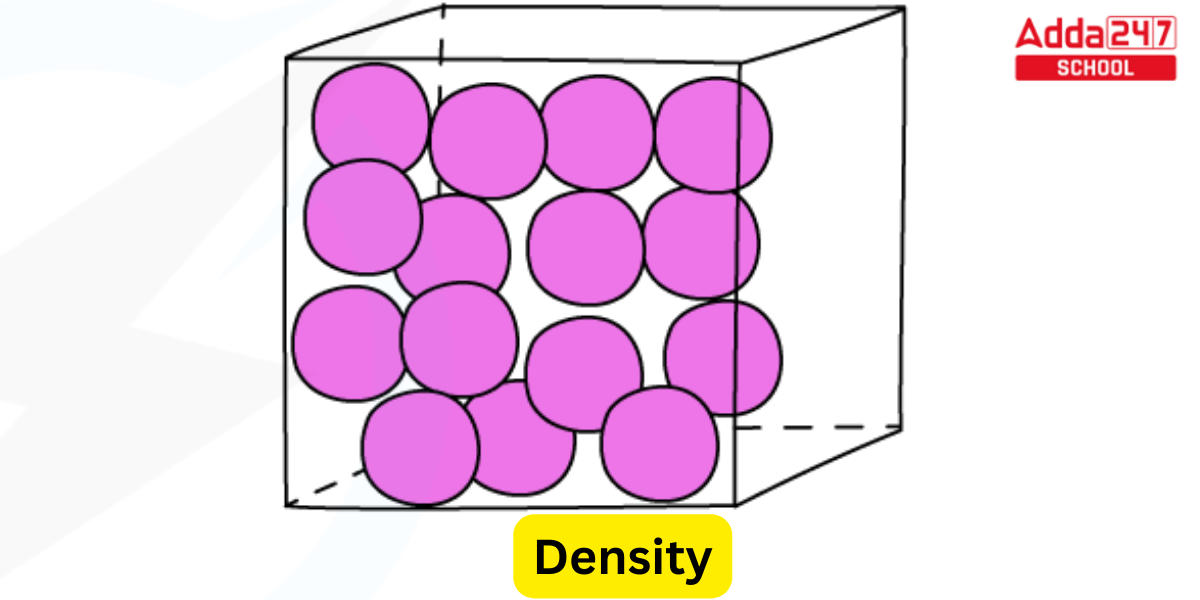Table of Contents
Density Means
The substance’s mass per unit of volume is known as its density (volumetric mass density or specific mass). Although the Roman letter D may also be used, the sign most frequently used for density is ρ (the lower case Greek letter rho). The formula for density is mass divided by volume:
where m is the mass, V is the volume, and ρ is the density. Density is sometimes roughly characterised as weight per unit volume, while this is incorrect scientifically; this quantity is more precisely known as specific weight. One example of this is in the US oil and gas business.
Meaning of Density
The density of a pure substance is equal to its mass concentration in numbers. Density varies widely among materials and may be important in relation to packaging, purity, and buoyancy. The densest known elements under conditions of normal temperature and pressure are osmium and iridium.
It is occasionally substituted by the dimensionless quantity “relative density” or “specific gravity,” which is the ratio of the density of the material to that of a standard material, typically water, to make density comparisons across different systems of units easier. A substance floats in water if its relative density to water is less than one.
A substance’s density changes as a function of pressure and temperature. For solids and liquids, this variance is often minimal, but for gases, it is much more pronounced. An object’s density increases as pressure is applied, which causes the object’s volume to decrease. With a few exceptions, a substance’s density falls as its volume increases as its temperature rises. Due to the heated fluid’s reduced density, which causes it to rise in relation to the denser unheated material, heating the bottom of a fluid typically promotes convection of heat from the bottom to the top.
The phrase “specific volume” is occasionally used in thermodynamics to refer to a substance’s reciprocal of its density. As increasing a substance’s mass increases its mass rather than its density, density is an intense attribute.
Specific weight, relative density (specific gravity), and specific density are other numbers or ratios that are conceptually equivalent.
Islands of India Names, List, Map, PDF
Density Meaning
There are numerous methods and standards for calculating a material’s density. The use of a hydrometer (a buoyancy method for liquids), a hydrostatic balance (a buoyancy method for liquids and solids), the immersed body method (a buoyancy method for liquids), a pycnometer (a buoyancy method for liquids and solids), an air comparison pycnometer (a buoyancy method for solids), an oscillating densitometer (a buoyancy method for liquids), and pour and tap are some examples of such techniques (solids). It is vital to understand the type of density being measured as well as the kind of material in issue because each specific method or methodology assesses a distinct sort of density (for example, bulk density, skeletal density, etc.).
Density Unit
Any unit of mass density is defined as mass divided by volume according to the density equation (ρ = m/V). There are various units for mass density in use since there are numerous units for mass and volume that cover a wide range of magnitudes. The most widely used units for density are probably the SI unit of kilogramme per cubic metre (kg/m3) and the cgs unit of gramme per cubic centimetre (g/cm3). 1000 kg/m3 is equal to one g/cm3. The unit of measurement for millilitre is one cubic centimetre, abbreviated as cc. Other, larger or smaller mass and/or volume units, as well as US customary units, may be employed in the industrial setting.
Density of Homogeneous materials
A homogeneous object has a density that is equal to its whole mass divided by its total volume at all places. The volume can be determined directly (from the geometry of the object) or by the displacement of a fluid, while the mass is often measured with a scale or balance. A hydrometer, dasymeter, or Coriolis flow metre can be used to measure the density of a liquid or a gas, respectively. Similar to this, hydrostatic weighing calculates an object’s density based on the displacement of water caused by a submerged object.
Density of Heterogeneous materials
The density of the body will vary in different parts of the thing if it is not uniform. In that situation, the density of a tiny volume surrounding a certain point is calculated to determine the density there. The density of an inhomogeneous object at a location in the limit of an infinitesimal volume is given by: , where dV is an elementary volume at position r. The body’s mass can then be stated as:
Density Non-compact materials
In reality, voids can be found in bulk solids like sugar, sand, or snow. In nature, many substances can be found as flakes, pellets, or granules. Voids are areas where there is not the material that is being considered. Although air is typically the emptiness, it could also be a vacuum, liquid, solid, or another gas or gaseous mixture.
A material’s bulk volume—including the vacancy fraction—can frequently be determined by a straightforward measurement (such as using a calibrated measuring cup) or geometrically from known dimensions. Bulk density is calculated as mass divided by bulk volume. The volumetric mass density is not the same as this.
In general, increasing either the pressure or the temperature will alter the density. The density of a material constantly rises as pressure does. There are notable exceptions to the general rule that density decreases as temperature rises. For instance, between the melting point of water at 0 °C and 4 °C, the density rises; silicon exhibits a similar pattern of action at low temperatures.
The densities of liquids and solids are only slightly affected by temperature and pressure. A typical liquid or solid has a compressibility of 106 bar1 (1 bar = 0.1 MPa), and its thermal expansivity is 105 K1. This amounts to roughly requiring ten thousand times the atmospheric pressure to decrease a substance’s volume by one percent. (But, for some clays and sand, the required pressures might be a thousand times lower.) The normal temperature increase needed to achieve a volume expansion of 1% is in the thousands of degrees Celsius range.
Density of Various Materials
| Material | Density |
| Hydrogen | 0.0898 |
| Helium | 0.179 |
| Aerographite | 0.2 |
| Metallic microlattice | 0.9 |
| Aerogel | 1.0 |
| Air | 1.2 |
| Tungsten hexafluoride | 12.4 |
| Liquid hydrogen | 70 |
| Styrofoam | 75 |
| Cork | 240 |
| Pine | 373 |
| Lithium | 535 |
| Wood | 700 |
| Oak | 710 |
| Potassium | 860 |
| Ice | 916.7 |
| Cooking oil | 910–930 |
| Sodium | 970 |
| Water (fresh) | 1,000 |
| Water (salt) | 1,030 |
| Liquid oxygen | 1,141 |
| Nylon | 1,150 |
| Plastics | 1,175 |
| Glycerol | 1,261 |
| Tetrachloroethene | 1,622 |
| Sand | 1,600 |
| Magnesium | 1,740 |
| Beryllium | 1,850 |
| Silicon | 2,330 |
| Concrete | 2,400 |
| Glass | 2,500 |
| Quartzite | 2,600 |
| Granite | 2,700 |
| Gneiss | 2,700 |
| Aluminium | 2,700 |
| Limestone | 2,750 |
| Basalt | 3,000 |
| Diiodomethane | 3,325 |
| Diamond | 3,500 |
| Titanium | 4,540 |
| Selenium | 4,800 |
| Vanadium | 6,100 |
| Antimony | 6,690 |
| Zinc | 7,000 |
| Chromium | 7,200 |
| Tin | 7,310 |
| Manganese | 7,325 |
| Iron | 7,870 |
| Mild Steel | 7,850 |
| Niobium | 8,570 |
| Brass | 8,600 |
| Cadmium | 8,650 |
| Cobalt | 8,900 |
| Nickel | 8,900 |
| Copper | 8,940 |
| Bismuth | 9,750 |
| Molybdenum | 10,220 |
| Silver | 10,500 |
| Lead | 11,340 |
| Thorium | 11,700 |
| Rhodium | 12,410 |
| Mercury | 13,546 |
| Tantalum | 16,600 |
| Uranium | 18,800 |
| Tungsten | 19,300 |
| Gold | 19,320 |
| Plutonium | 19,840 |
| Rhenium | 21,020 |
| Platinum | 21,450 |
| Iridium | 22,420 |
| Osmium | 22,570 |






 NBEMS NEET PG 2025 Registration (Active)...
NBEMS NEET PG 2025 Registration (Active)...
 CUET UG Exam Date Sheet 2025 @cuet.nta.n...
CUET UG Exam Date Sheet 2025 @cuet.nta.n...
 UP, MP, CBSE Board Result 2025 Live Upda...
UP, MP, CBSE Board Result 2025 Live Upda...










